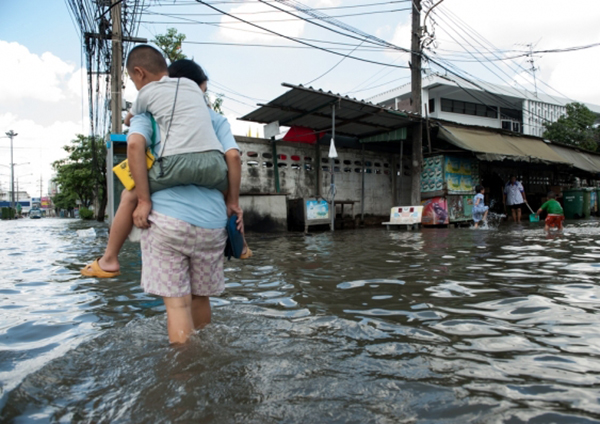
Heavy flooding from monsoon rain in Samutprakarn near Bangkok, Thailand in 2009.
The latest Red Cross World Disasters Report is calling for a radical change in the way we manage and prepare for natural disasters.
Edited by UNSW’s Judith Neilson Chair in Architecture Professor David Sanderson the report calls for investment in preventing and mitigating risks before disaster strikes.
Produced annually by the International Federation of Red Cross and Red Crescent Societies the report includes comprehensive disaster data and analysis on disaster management.
Natural disasters cost Australia at least $9 billion last year, according to the Australian Business Roundtable for Disaster Resilience and Safer Communities, with the cost forecast to double by 2030 and reach $33 billion per year by 2050.
“Investing in disaster resilience will save lives and money,” says Professor Sanderson, an international disaster risk-reduction expert. “Disasters killed 32,550 people last year, including 16 Australians, and affected 108 million people worldwide. Over the past 10 years, 1.9 billion people have been affected.”
Professor Sanderson describes the current global situation as a “heady cocktail” of unprecedented circumstances.
Investing in disaster resilience will save lives and money. Disasters killed 32,550 people last year, including 16 Australians, and affected 108 million people worldwide. Over the past 10 years, 1.9 billion people have been affected.
“The need to change the way we deal with disasters is great: forced migration from conflict is at its highest since World War Two; the number and scale of disasters triggered by natural hazards are increasing, 2015 was the hottest year ever recorded, and the current aid sector which hasn’t changed for 75 years is struggling to cope.”
However, there is growing evidence that death and injury is reduced by investing in early warnings and preparing for disasters, with last year’s global death toll less than half of the average for the past 10 years.
“Building resilient communities who are capable of anticipating and reducing the impact of disaster before it strikes is critical to managing disaster risk-reduction,” Professor Sanderson said.
Australian Red Cross CEO Judy Slatyer said only one out of every eight dollars spent on disasters goes towards reducing risks.
“It’s time to build resilience by rebalancing the way we invest in aid and mitigate the affect of disasters. Preparing for floods, fires, cyclones and all disasters must become normal, like wearing a seat belt in a car.
“Our research and experience shows us that preparing well for disasters saves countless lives and helps people respond to disasters best and recover more quickly. It’s smart to reduce risk and invest in a safer future,” Ms Slatyer said.
Professor Sanderson says disasters should be approached in the same way as preventative healthcare.
“You stop the diseases from happening in the first place and that’s where disasters should sit. We can do a lot about this situation, the challenge is not too big, we just need to take it seriously.”
World Disasters Report – snapshot
- There were 574 disasters in 2015, affecting 108 million people worldwide.
- Last year, 16 Australians were killed by disasters, including in floods and fires while Nepal experienced the highest toll of 9,034 lives lost in two earthquakes.
- In 2015, 67 per cent of people killed by disasters lived in Asia, above the decade’s annual average of 50.5 per cent.
- In Asia, the number of people affected by disasters last year was the lowest of the decade.
- In contrast, in the Pacific region including Australia, the number of people affected by disasters was the highest of the decade, reaching five times the decade’s average.
- Weather-related disasters are displacing 22.5 million people each year since 2008 – the equivalent of 62,000 people every day.
- 2015 was the hottest year since modern records began in 1880 and continues a trend – 15 of the 16 hottest years on record have now occurred since 2001. The 2015 record is a globally-averaged temperature that surpassed the 2014 record by 0.13 degrees Celsius. (NASA 2015).
- Global economic losses from extreme weather events alone are now in the range of AU$ 198-264 billion dollars annually.
- 65.3 million people were forcibly displaced at the end of 2015, compared to 59.5 at the end of 2014. This is the highest figure ever recorded by UNHCR.
- The rate at which people are fleeing war and persecution has soared from 6 people per minute in 2005 to 24 people per minute in 2015, according to the UNHCR.
Read the full 2016 World Disasters Report here.
Listen to Professor Sanderson discussing the report on ABC Radio National.
